I was reading the mail on a net on 40m one day many years ago, and one of the participants asked people for their recommendation on his intended ATU purchase. This was pretty technical for this net where the qualification to join is that you tell all what you are going to have for dinner.
So, one of the guys tells ’em “mine will tune the proverbial wet string.”
Gotta do better than that? Next guy says “mine is so good… I tuned up the other day for a perfect match then thought the band was a bit dead until I realised I did not have an antenna connected!”
Let’s work a real example
MFJ claimed that the MFJ-949E is the most popular tuner purchased… so lets use it as an example.
We will use 160m as I measured the magnetising impedance of the internal balun a few days ago and used in the a recent article. This article uses the same basic model… but no antenna connected.
Above is the test setup, NanoVNA connected to the transmitter jack, mode switch set to Tuned / Balanced… and there is no antenna on the balanced line terminals (the balun link is in place). Continue reading My ATU is soooo good, it will give a perfect match on anything, even…




